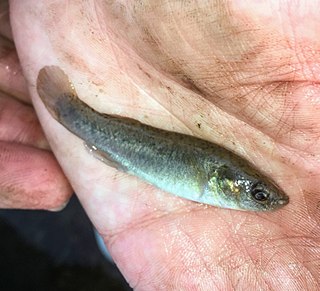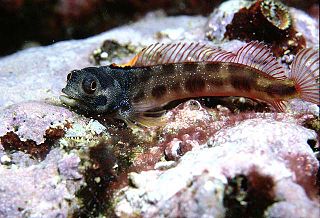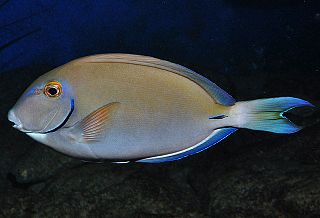
The cherubfish, also known as the pygmy angelfish, is a species of marine ray-finned fish, a marine angelfish belonging to the family Pomacanthidae. It is found in the western Atlantic Ocean.

The Iceland or Icelandic catshark is a species of catshark, belonging to the family Scyliorhinidae. This catshark is found in the western Atlantic, from Massachusetts, Delaware, and the northern Gulf of Mexico, as well as the eastern Atlantic from Iceland, southwestern Ireland, the Canary Islands, Madeira, South Africa, and between 67 and 11°N. They are found in depths of 550 to 1450 meters near or at the bottom over upper continental slopes.

The longnose catshark is a catshark of the family Scyliorhinidae found in the eastern central Pacific from central and southern California and the Gulf of California, between latitudes 38° N and 23° N, at depths down to 1,890. Its length is up to 58 cm.

The saltmarsh topminnow is a species of killifish for the family Fundulidae. It occurs in the coastal wetlands of the Gulf of Mexico in the United States.
The dusky jawfish is a species of jawfish native to the western Atlantic Ocean including the Gulf of Mexico and the Caribbean Sea where it is an inhabitant of reefs at depths of from 1 to 12 metres. It can reach a length of 14 centimetres (5.5 in) TL. This species can also be found in the aquarium trade.
Antennablennius simonyi, Simony's blenny, is a species of combtooth blenny found in the western Indian Ocean, from the Gulf of Aden to the Persian Gulf.
Lupinoblennius nicholsi, the highfin blenny, is a species of combtooth blenny found in the western Atlantic ocean, on the coasts of the Gulf of Mexico in north-eastern Mexico and Texas, it has also been recorded from Englewood, Florida. This species reaches a length of 6 centimetres (2.4 in) TL. The specific name honours the American ichthyologist John Treadwell Nichols (1883-1958).
Tanyemblemaria alleni, the slender blenny, is a species of chaenopsid blenny found around Panama, known from one species collected at Isla del Rey. It can reach a length of 5.4 centimetres (2.1 in) TL. The specific name honours the collector of the type, Gerald R. Allen of the Western Australia Museum in Perth.

Acanthemblemaria hastingsi, the Cortez barnacle blenny, is a species of chaenopsid blenny found in the Gulf of California, in the eastern Pacific Ocean. Males can reach a maximum length of 5.1 cm (2.0 in) SL, while females can reach a maximum length of 4 cm (1.6 in). The specific name honours the marine biologist Philip A. Hastings of the Scripps Institution of Oceanography.

Starksia spinipenis, the phallic blenny, is a species of labrisomid blenny native to the Pacific coast of Mexico from the Gulf of California to Acapulco. It prefers shallow sandy areas with weed growth. This species can reach a length of 5 centimetres (2.0 in) TL. The specific name is a compound noun if spinis meaning "spine" and penis, a reference to the first spine in the anal fin of the males which is elongated and free of the fin membrane and is modified as a copulatory organ, a characteristic of the genus Starksia.
Gobius senegambiensis is a species of marine fish from the family Gobiidae, the true gobies. It is native to the Atlantic Ocean from Morocco to Angola as well as the islands in the Gulf of Guinea. It is found in inshore waters on sandy bottoms. This species can reach a length of 7.3 centimetres (2.9 in) SL.

Acanthurus tractus, the five-band surgeonfish, ocean surgeon, or ocean surgeonfish, is a species of ray-finned fish in the family Acanthuridae found in the western Atlantic Ocean, Florida, the Bahamas, the Caribbean Sea and the Gulf of Mexico. Until recently, it was considered a synonym of Acanthurus bahianus, but its status as a separate species was resurrected in 2011.

The Gulf bareye tilefish, also known as the anchor tilefish, is a species of marine ray-finned fish, a tilefish belonging to the family Malacanthidae. It occurs in the western Atlantic Ocean.

Ophidion josephi is a fish species in the family Ophidiidae. Widespread in the Western Atlantic from Georgia to Florida, also in the Gulf of Mexico. Marine tropical demersal fish. The specific name josephi refers to St Joseph Island in Texas where the type specimen was collected.
The Bullish conger is an eel in the family Congridae. It was described by David G. Smith and Robert H. Kanazawa in 1977, originally under the genus Rhechias. It is a marine, deep water-dwelling eel which is known from the Gulf of Mexico to the Amazon, in the western Atlantic Ocean. It dwells at a depth range of 366–475 meters. Males can reach a maximum total length of 39.5 centimeters.

Apolemichthys xanthotis, the yellow-ear angelfish or Red Sea angelfish, is a species of marine ray-finned fish, a marine angelfish belonging to the family Pomacanthidae.

Canthigaster jamestyleri, known as the goldface toby, is a species of marine fish in the family Tetraodontidae. It was first isolated from the southeast coast of the US, in the Atlantic Ocean.

Halichoeres burekae, the Mardi Gras wrasse, is a species of wrasse native to the Gulf of Mexico. The species was first described from the Flower Garden Banks National Marine Sanctuary, in the northwestern Gulf of Mexico, but has since been recorded in other areas of the southern Gulf of Mexico. Because it is a small species that feeds on plankton in the water column, it is likely a preferred prey for invasive Lionfish. It also has a very restricted range, and corresponding relatively small population, what resulted in this species being listed as Endangered in the IUCN Red List.

Cocco's lantern fish, also called Gemellar's lanternfish, is a species of lanternfish.
Bathyraja taranetzi, the mud skate, is a species of skate in the family Arhynchobatidae found in the north-western Pacific Ocean.













